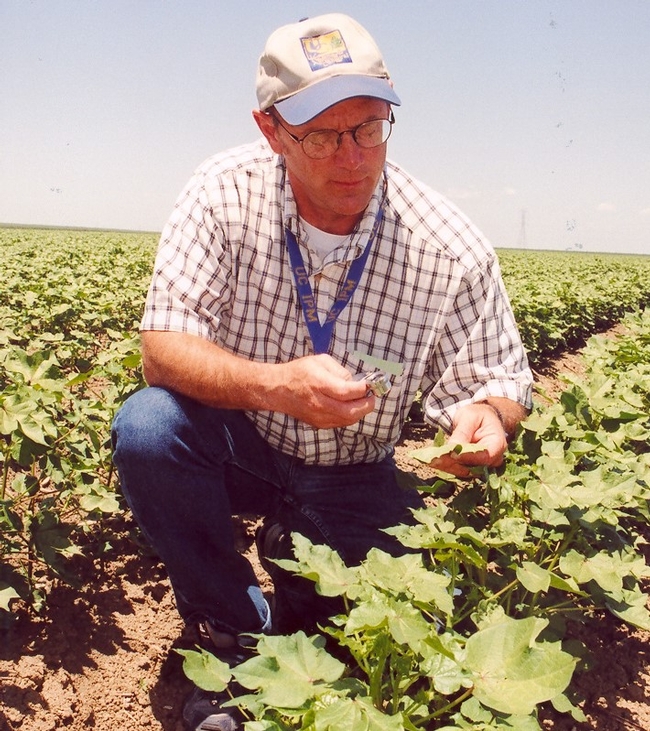Long-time UC Integrated Pest Management advisor Pete Goodell retires June 30
A 36-year career in science led UC Cooperative Extension Integrated Pest Management advisor Pete Goodell to a gratifying conclusion. He found that technical pest management skills are critical, but it's the people skills he has developed over time that were key to bringing about change.
Goodell retires June 30 from what he described as a fulfilling and challenging career that he entered by pure happenstance. His role as a researcher, leader and teacher turned out to be the perfect profession for someone with his interests, skills and passion.
Unable to find a job in forestry after completing an ecology degree at California State University, San Francisco, Goodell answered an ad he saw on a UC Berkeley bulletin board seeking staff to collect insect samples in a hot Los Baños cotton field.
“It wasn't what I wanted, but it got me outdoors and it was very satisfying,” Goodell said. “I was able to use a lot of what I learned in field biology at San Francisco State.”
The job opened the door into the world of agricultural entomology, a scientific field that impacts the most basic of human endeavors, food production. Captivated by the opportunity to make a difference, Goodell continued his education at UC Riverside, where he studied nematology, entomology and plant pathology, earning masters' and doctorate degrees. Just as his education wound down in the early 1980s, there were rumblings in the California State Legislature about the implementation of new regulations aimed at reducing pesticide use.
Jim Farrar, director of the Statewide UC IPM Program, attributed a large part the program's success to Goodell's contributions.
“Pete delivered innovative IPM programs ranging from technical pest sampling strategies to the social science of how people learn and adopt new pest management techniques,” Farrar said.
In the early days, the program focused on producing IPM manuals for the crops that were the highest pesticide users. Teams were established to research, collect and deliver best practices for alfalfa, grapes, walnuts, almonds, rice, cotton, tomatoes and citrus pest management.
“In the UC IPM program we worked together across disciplines, so we got a lot done,” Goodell said.
Today a library of integrated pest management books, leaflets, training resources, websites and blogs deliver UC's best information on managing pests using safe and effective techniques and strategies that protect people and the environment.
The list of Goodell's accomplishments and awards is long. To name just a few, his efforts have been recognized with two Distinguished Service Awards from UC Agriculture and Natural Resources, a Lifetime Achievement Award from the Association of Applied IPM Ecologists, and even being named by US News and World Report as one of the “Ten Most Indispensable Americans.”
One of the concepts that has defined his career is regional integrated pest management, which pushes the management of pests beyond the boundaries of individual farms.
“When you have a mobile insect, one farmer's decisions can impact the entire community,” Goodell said. “Working together, you can mitigate that problem.”
Goodell worked closely with farmers in the Tulare Lake basin to implement a regional IPM management system. Goodell brought together 10 growers, each managing several hundred thousand acres of farmland, to collaborate on the Lygus bug problem in cotton.
“Lygus bugs build up in safflower. When the safflower is harvested, all the bugs move into cotton and you have to spray pesticides,” Goodell said.
Safflower is an important part of the crop rotation system, so Goodell got the farmers together to decide on a management scheme.
“One acre of safflower can infest 10 acres of cotton. If you spray the safflower, you reduce the area sprayed by a factor of 10,” he said. “The growers all agreed to spray safflower on the same day, before the Lygus bugs get their wings and lay eggs. This reduced pesticide use considerably.”
The coordination was a complex process. “I was privileged to work with such a motivated and engaged community of farmers,” Goodell said.
The same kind of regional management was proposed for a group of growers near Firebaugh, but Goodell found it nearly impossible.
“In the Firebaugh area, numerous farmers with small fields and tremendous diversity of crops was an insurmountable challenge,” Goodell said. “But in the Tulare Lake basin, we showed that regional IPM can work. This is a model that can be used for other insect and disease problems in the future, such as Asian citrus psyllid and glassy winged sharpshooter.”
Goodell has applied for emeritus status to continue his work in collaborative entomology during retirement. He and his colleagues plan to bring together a diverse group of Californians to enhance understanding of pests, pesticides, and integrated pest management.
“We'll have farmers, pest control advisers, farmworkers, day care operators and managers of open areas like golf courses and public parks all in the same room,” Goodell said. “We want to understand where we need our research to be going, and how to bridge the gap between those who think all pesticides are bad and those who believe pesticides are critical to their businesses.”
In retirement, Goodell will also pursue his passion for the Great Outdoors. He plans to hike the John Muir Trail one segment at a time, and visit the National Parks in the western United States in style, by staying at historical lodges.
Getting reservations won't be a problem. “We have a very open calendar,” Goodell said.


Posted by Andrew Sutherland on June 2, 2017 at 11:30 AM